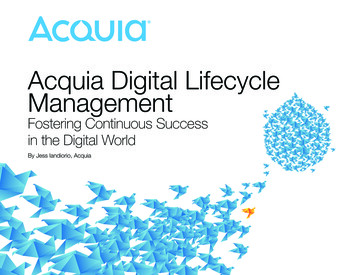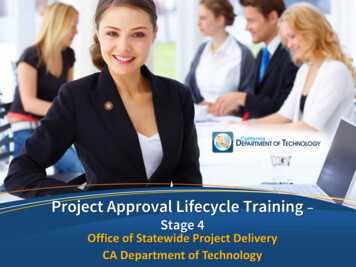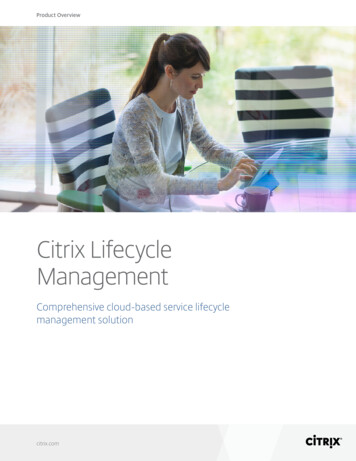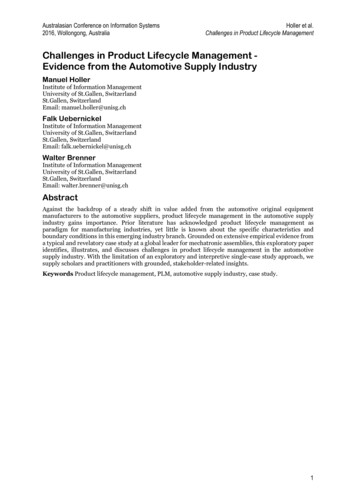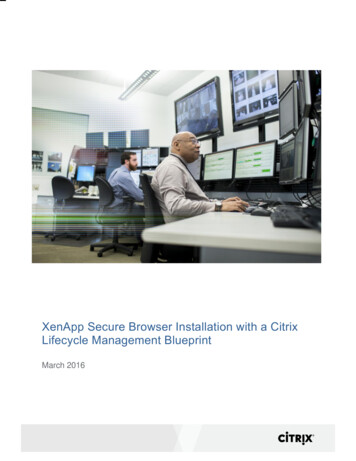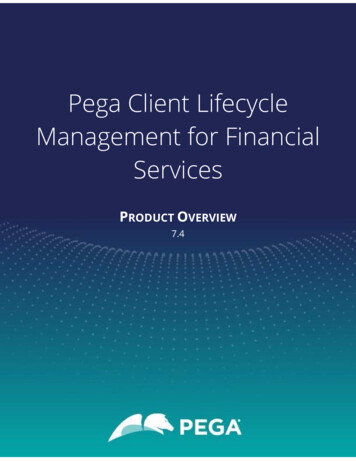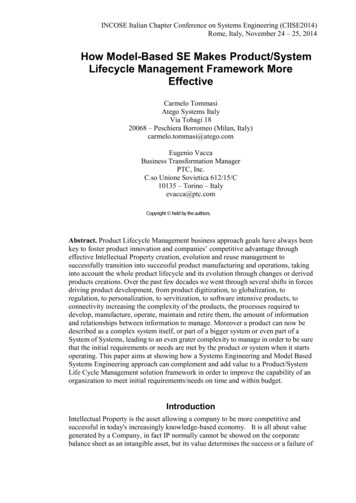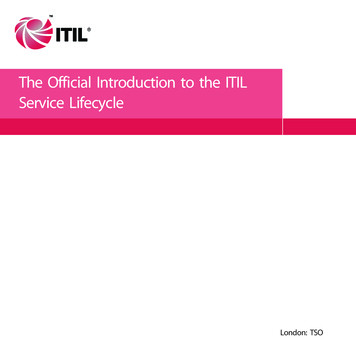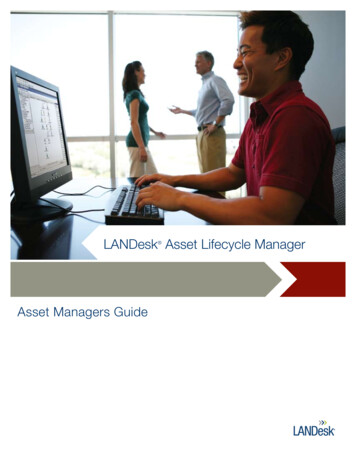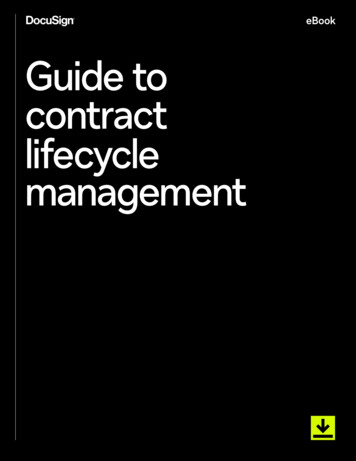
Transcription
eBookGuide tocontractlifecyclemanagement1
OverviewIf your growing business is struggling to manage the contractprocess, you are not alone. As businesses scale, sales contractvolume often quickly exceeds the capacity of the small legalteam that must manually negotiate and review all contractlanguage. The result is delays in the sales process that canfrustrate employees and customers, create potential risk andultimately slow down business growth.Innovative and fast-growing companies use contractmanagement software solutions such as contract lifecyclemanagement (CLM) to make the agreement process easier andmore efficient. You may be aware that CLM can help addressthe problems you’re facing, but perhaps your support team isconcerned about a cumbersome implementation process thatcould be expensive and time consuming. There are, however,CLM solutions that can be set up to quickly and cost effectivelyaddress your immediate contracting challenges.But what exactly is CLM, and how do you know if yourorganization could benefit from it? In this eBook, we defineCLM, share common use cases and help you discern whetherit’s the right fit for your company. If CLM’s capabilities arethe answer to your organization’s needs, you can follow ourtips for selecting a quality solution and take the first step intransforming your agreement process.DefinitionContract lifecycle management (CLM):The proactive, automated management of the contract processfrom generation through negotiation, signature, ongoingmanagement and storage. Today, this is most commonly achievedusing a purpose-built software tool.Guide to contract lifecyclemanagement2
Stages of thecontract lifecycleTo understand CLM, let’s first look at the different stages of the contract process.The contract lifecycle looks similar across departments, organizations and even industries.Below are five key stages that comprise the contract lifecycle.14Generating contractsObtaining signaturesBefore a contract can be signed, someonehas to gather information and draft thedocument’s language. Sometimes thisprocess starts from scratch, but more oftenit begins with an existing template, in whichcase only key details need to be updated.Once a contract has been accepted byall parties, it’s time to sign. While wetink signatures make signing a lengthyprocess, electronic signatures are almostinstantaneous. Signers can create asecure and verifiable signature on anydevice, complete with an audit trail forfuture authentication.2Negotiating termsContract negotiation can involveconsiderable back and forth betweenparties, whether internal or external, tosettle on terms and conditions. On average,this step takes longer than any other inthe contract process,1 creating a majorbottleneck if you lack proper tools.35Storing and searching contractsFor best (and compliant) recordkeeping,you need a secure place to store yourcontracts. Ideally, that location is alsosearchable and centralized, allowingauthorized users in your organizationremote access and reducing the timeit takes to find specific agreementsor language.Routing contracts for reviewand approvalSending contracts to the appropriateparties in the appropriate order for reviewand approval can create additional hurdlesand introduce risk if adequate safeguardsaren’t in place. On average, most contractsgo through three to four versions beforebeing finalized, and most approvalprocesses involve four to five people.2Guide to contract lifecyclemanagement3
How CLM worksIn addition to consolidating every step of the contract process in one secure location,CLM automates numerous tasks within these steps, ultimately reducing risk and timeto completion.Core functionalities of CLM include:Document generationSignatureCLM helps your sales team create new,accurate contracts from the start, allwhile staying within Salesforce or anothersystem of record. Using preconfiguredtemplates that autofill with legalapproved language and customer datafrom Salesforce, your sales team doesn’thave to modify documents on their ownand can spend more time selling.Through a seamless, digital signingexperience, CLM dramaticallyreduces the wait time for signatures.Stakeholders can quickly consent withe-signature technology, and workflowsautomatically move the documentthrough subsequent steps.CollaborationA CLM solution serves as a single placewhere all parties can easily collaborateon and manage contracts. Users canedit, comment, assign tasks, trackchanges and compare versions to reachconsensus. No more searching for thelatest version or wondering who stillneeds to review.WorkflowsCLM automates the flow of contractsbased on business rules such as the typeof agreement or the amount of moneyinvolved, freeing you from figuring outwho’s supposed to sign or review next.Once the review stage is complete, CLMcan automatically initiate other steps, likestoring the contract in the proper placeor sending it to billing or provisioning.Guide to contract lifecyclemanagementStorageContracts are stored in a centralizedand searchable location, saving yourlegal team valuable time by keepingdocuments secure and easily accessible.CLM also allows for advanced controlof user permissions, preventingunauthorized users from retrieving orviewing documents.AnalyticsCLM makes it easier for a legal teamto track milestones and obligations incontracts. It can also flag high-risk termsin a negotiated agreement to ensure youknow what you’re signing and give legal ahead start on review.IntegrationsBy connecting with Salesforce andother existing systems, CLM cuts downon redundant, manual tasks and letsstaff members work within the softwaresolutions they already know and use.4
Benefits of CLMA CLM solution can bring numerous benefits to almost every department in yourorganization. These include:83% reductionin contract process time by organizationsthat use CLM3Increased efficiencyBetter organizationWith major bottlenecks eliminated, thecontract process speeds up so dealsclose sooner, expediting the timeto revenue.Digital documents are stored in asecure, central location that allows forcontrolled access and easy retrieval.CLM also creates a single source oftruth across systems.Reduced riskRules within workflows ensure contractsmeet your guidelines, while artificialintelligence enables you to identify riskareas based on market conditions.Increased productivityStaff are freed up to spend more timeon high-value strategic work and lesstime on repetitive contract-related tasks.Reduced error rateGreater visibilityCLM can pull and share data directly fromother systems of record, eliminating entryerrors and discrepancies.Staff gains full visibility into agreements,including who made changes to eachversion and why.Better experienceMake a positive first impression oncustomers and partners with a fast andeasy contract process.Guide to contract lifecyclemanagement5
How to use CLMRegardless of your industry, CLM solutions can streamline complex contracting processesand are most often used in legal, sales and procurement departments.These three common use cases illustrate the organizational breadth of a CLM solution:After implementing a CLM solution,the average business sees:450% reductionin contract completion time80% reductionin contract drafting timeSalesProcurementCLM empowers sales teams to do moreon their own, close deals faster and stayon top of contract status. With one click,teams can generate contracts usingpreapproved templates and language.If a contract gets stuck with an internalor external party during negotiation,collaboration tools keep sales in the knowso they can follow up. Digital signaturewithin the CLM solution helps salesteams close deals and generate revenuefaster while workflows can automaticallyupdate the CRM to closed-won, thenstore contracts in CLM.84% of supply chain managersidentify low contract visibility duringthe procurement process as theirbiggest challenge,5 making it difficultto reduce vendor overspend. With CLM,procurement gets the 360-degreevisibility it needs to see where there aremultiple contracts with the same vendoracross the organization, and eithereliminate duplicate purchases or leverageconsolidated buying power to lowercosts. CLM also makes it easier to reducerate overpayments, cancel auto renewals,and renegotiate contracts. What’s more,with a solution that leverages AI to createrisk scores, procurement teams no longerhave to manually analyze every vendorcontract and can instead focus on moreimportant tasks.LegalWith CLM, legal teams can minimize risk,increase efficiency and keep businessmoving. They can create preapprovedclauses to help other departments bemore self-sufficient, while benefitingfrom greater visibility and a searchablerepository of stored contracts. Legal canalso tap into CLM’s deep analytics, trackcompany obligations and milestonesand use the power of AI to score riskin contract terms and redline incomingagreements.Guide to contract lifecyclemanagement6
How CLM solutionswork with othersystemsExamples of contracts CLMcan help manageLegalNDAsRegulatory or government filingsContract compliance auditsPartner agreementsSalesMaster Service AgreementsOrder formsSales contractsDistribution agreementsSpecial deal termsProcurementSupplier agreementsStatements of workMaster Service AgreementsRisk waivers and exceptionsAmendments and change ordersFinanceLeasing agreementsAccount openingAsset transferClaims settlementClient onboardingSelecting a CLM that offers a broad range of integrations will add to its convenienceand power. By pulling data from existing systems, CLM reduces manual input and ensuresuniform information across all platforms. Here are just a few examples of CLM integrationcapabilities, though these can vary depending on the CLM solution you choose:Customer relationshipmanagement (CRM)Human capital management (HCM)Autofill agreements with information fromSalesforce, Microsoft Dynamics or anotherCRM, and create a single source of truthbetween systems.Increase efficiency and create a bettercandidate and employee experienceby managing the agreement processwithin Workday, SuccessFactors oranother HCM.Enterprise resource planning (ERP)MoreStreamline finance, operations, supply chainand other processes by integrating withOracle, SAP, Workday Financial Management,NetSuite Financials or other ERPs.Robust CLM solutions have a range ofprebuilt integrations, as well as an API forbuilding custom integrations, so you canfully automate your contract process.Procure-to-payAchieve full visibility into the vendor contractlifecycle, identify risks and capitalize onsavings opportunities by integrating withyour procure-to-pay system, such as SAPAriba or Oracle Procurement Cloud.Many moreFranchise agreementsVendor contractsStatements of workLand deeds or real estateEmployee onboardingSubcontractor agreementsGuide to contract lifecyclemanagement7
Assessing whetheryour organizationcan benefit from aCLM solutionWithout a CLM solution, it takeson average:645 minutesto locate a stored contract1 hr 24 minto locate a section of terms for referenceDue to manual tasks and inadequatetechnology, professionals have facedthe following challenges, accordingto recent DocuSign surveys:26%have shared a contract with thewrong party746%have been unable to locatea stored contract890%Many organizations are weighed down by inefficient contract processes, but still aren’tsure if a CLM solution is right for them. If the descriptions below are applicable to yourteam, then your organization is likely a great fit for a CLM solution.Criteria: Your contracts andprocesses are complexCriteria: There are often mistakesand errors in your contractsThere are many people and systemsinvolved in your contract process, or yourcontracts themselves are complex, withdifferent clauses depending on bundling,discounting, regulations, SKUs and more.You copy and paste important detailsinto your contracts. This inevitably leadsto errors that cause delayed closings,higher costs, missed opportunitiesand noncompliance risk within yourorganization.Criteria: There are frequentbottlenecks in your contract processYou find that your team’s contracts areoften stalled at the generation, approvalor signing stages, creating a slow processand poor experience.Criteria: Your contract processopens the organization to riskCriteria: Your completed contractsare disorganized and even lostYour contracts aren’t safely stored in acentralized location. No single personkeeps track of specific documents,versions, clauses or language, hinderingefficiency and responsiveness.You don’t have standardized workflowsand your team resorts to email,spreadsheets or other contractmanagement methods that jeopardizesecurity, compliance and auditing.said that human error has a significantimpact on their contracting proces9Guide to contract lifecyclemanagement8
Simplifying theagreement process:customer examples356% ROIseen by composite organizations after three yearsof using DocuSign CLM10Guide to contract lifecyclemanagement9
Customer storyGenesys“Today, we have astandardized process—from start to finish—that allows accountexecutives to see wheretheir documents are inthe process (instanttracking), reduces theback and forth andhelps them close dealsfaster and smoother.”Genesys, a leader in CX and call centersolutions, experienced rapid growthat the onset of the pandemic. Just asits global workforce went remote, thecompany began seeing larger dealsizes and hundreds of new customers.Suddenly, the multiple handoffs andad hoc tools that made up its contractmanagement process became slow andcumbersome. To accelerate the process,Genesys needed a robust contractingsystem and turned to DocuSign CLM.The implementation unlocked significantbenefits for the company acrosssales, legal, procurement and financedepartments.As a result, Genesys saw:– 50–60% less time spent fromcontract generation to signature– 30 minutes or less to turn aroundstandard contracts– 100% of approvals tracked– Greater visibility into service ordersand data processing agreements– Enhanced search capabilities– Metadata extracted from all contractsfor better analysisCorey BischoffSVPGenesys global sales operationsGuide to contract lifecyclemanagement10
Customer storyFlexential“With DocuSign, we wereable to absorb the twocompanies’ agreementprocesses and see betterefficiency with repsnever leaving Salesforce.Sales can now createhighly complex customquotes with a click,send them out, and getthrough redlining andnegotiation easily. Allwhile tracking statusalong the way. They loveit and we love it.”Flexential, an IT infrastructure company,needed to simplify its sales workflowsand better manage sales agreements—all amid a merger. As the two companiescame together, sales reps struggled tocustomize complex quotes, negotiationswere slow and painful and data entry wasfilled with errors.With DocuSign CLM in place, theFlexential sales team realized:– 25% shorter sales cycle– 75% fewer manual transactions– 0 errors– Integration with Salesforce andServiceNow– Increased partner sales– No risk of lost contractsJason RaderSr. Director OperationsFlexentialGuide to contract lifecyclemanagement11
Do business betterwith DocuSign CLMThere are a lot of CLM solutions on the market but DocuSign CLM stands out as a leader.Robust feature setSecurityIntegrationsDocuSign CLM supports a broad range ofuse cases from common to highly complex,and a robust set of features that can easilyscale to meet the evolving needs acrossyour organization.DocuSign meets stringent global securitystandards including ISO 27001:2013and SOC 2. DocuSign eSignature andDocuSign CLM are authorized at theFedRAMP Moderate Impact Level, thefederal government security standardsfor cloud services.DocuSign CLM is fully customizableand integrates with common systemswhere work is done like Salesforce,Ariba and many others so you canget the most out of CLM as well asincrease the adoption of your existingtechnology investments.Customer successGrowth pathOur proven approach delivers customersuccess by combining the power ofDocuSign CLM with the industry’s bestteam of agreement experts to get you upand running with speed and confidence.DocuSign CLM can help you startedvery quickly at low cost with an easypath to grow into more advancedfunctionality when you’re ready.Artificial intelligence (AI)AI makes CLM more useful by improvinganalytics, auto-tagging contracts for bettersearch and proactively identifying risks andopportunities. Consider how you could useAI now and in the future.Brand strengthAs a stable public company with over 1Mcustomers, DocuSign is the undisputedleader in contract management and weapply this experience to heavily investin the next generation of CLM and thebroader contracting process.Ready to learn more about how DocuSign CLM works?Explore the product page, or contact our sales teamfor more information.Notes12345678910The State of Contract Management, 2020Ibid.The Total Economic Impact of DocuSign CLM, 2020The State of Systems Agreement, 2020Building a Modern Agreement Workflow for Procurement, 2020The State of Contract Management, 2020Ibid.Ibid.The State of Systems Agreement, 2020The Total Economic Impact of DocuSign CLM, 2020About DocuSignDocuSign helps organizations connect and automate how they prepare, sign, act on and manage agreements. As part ofthe DocuSign Agreement Cloud, DocuSign offers eSignature, the world’s #1 way to sign electronically on practically any device,from almost anywhere, at any time. Today, over a million customers and more than a billion users in over 180 countries usethe DocuSign Agreement Cloud to accelerate the process of doing business and simplify people’s lives.DocuSign, Inc.221 Main Street, Suite 1550San Francisco, CA 94105For more informationsales@docusign.com 1-877-720-2040docusign.com12
13
Oracle, SAP, Workday Financial Management, NetSuite Financials or other ERPs. Procure-to-pay Achieve full visibility into the vendor contract lifecycle, identify risks and capitalize on savings opportunities by integrating with your procure-to-pay system, such as SAP Ariba or Oracle Procurement Cloud. How CLM solutions work with other systems
